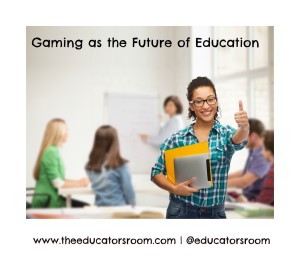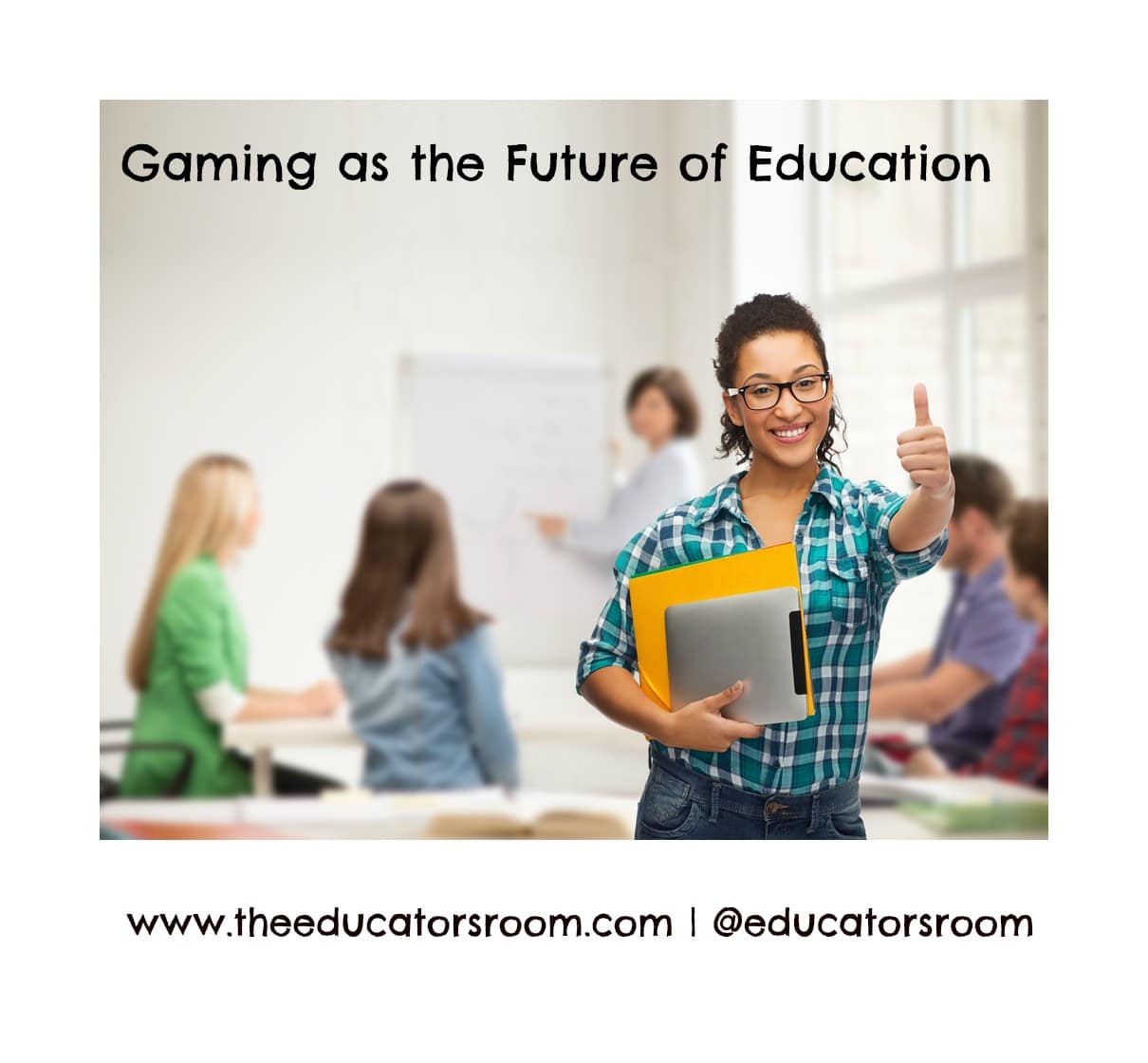 Like most boys his age, my 11 year-old son is a gamer. He plays a myriad of video games, and together, he and I are avid tabletop gamers. His gaming life is full of colorful characters, mysterious landscapes, adventure, challenge, triumphs, and, yes, lots of failure. But no matter how much failure he encounters, he continues to press on, to learn more, to beat the challenge and defeat the monster, understand the physics, or build the massive castle. He has that essential element of resilience we talk about in education: grit. And he has confidence even as he fails multiple times that he can figure out what he needs to figure out in order to succeed. But his life in school was a lot different than his gaming life, as it is for so many kids. Consider how your kids or your students engage with gaming compared to how they engage (or don’t engage) with their schoolwork. Currently, students have to code-switch between their vibrant gaming lives and their lives in the classroom. But what if they didn’t have to?
Like most boys his age, my 11 year-old son is a gamer. He plays a myriad of video games, and together, he and I are avid tabletop gamers. His gaming life is full of colorful characters, mysterious landscapes, adventure, challenge, triumphs, and, yes, lots of failure. But no matter how much failure he encounters, he continues to press on, to learn more, to beat the challenge and defeat the monster, understand the physics, or build the massive castle. He has that essential element of resilience we talk about in education: grit. And he has confidence even as he fails multiple times that he can figure out what he needs to figure out in order to succeed. But his life in school was a lot different than his gaming life, as it is for so many kids. Consider how your kids or your students engage with gaming compared to how they engage (or don’t engage) with their schoolwork. Currently, students have to code-switch between their vibrant gaming lives and their lives in the classroom. But what if they didn’t have to?
Like many families, we’ve made games out of all areas of our lives since my son was very small. Gamification is not a new idea; but most of us have only applied it unthinkingly, rather than as a central motivation for learning, growth, and relationship building in our lives. Research surrounding gaming and gamification theory continues to show positive outcomes for applying gaming to various aspects of our real lives. We often design and play games in the classroom with our students – and we see engagement, excitement, competition and collaboration, and, if we design the game well, really strong critical thinking as a result. As noted in Part 1 of this series, the increased reliance on our old industrialized model of education and its standardized assessments is actually opposite of what will truly engage, challenge, and excite students about learning in our modern, digitized world.
K-12 Education has not been a place of very much disruptive innovation. If you haven’t heard this term, disruptive innovation was coined by Clayton Christensen and describes an idea or product that “takes root initially in simple applications at the bottom of a market and then relentlessly moves up market, eventually displacing established competitors.” Yes, we get new ideas all the time in K-12 education (how many new sets of acronyms have you had to learn over the years of your teaching?). But how long do those new ideas last in your school or your district? Think of all of those initiatives you’ve had to implement that just faded away with no follow up. Nationally, NCLB was probably the longest lasting of the forced initiatives, and yet it never changed any education paradigms, only further entrenched the old ways of doing things. And it made education more difficult to love in the process. And now, even NCLB has gone by the wayside in most states. The reason these initiatives, and most other “innovations” in education (charter schools, vouchers, more testing, “smaller schools,” more testing…) fail is because they have never been truly transformative. They have never taken root and effectively disrupted the outdated, industrialized model of education in which students and teachers alike are still trapped.
On the other hand, post-secondary education is currently experiencing a disruptive innovation that may very likely spread to K-12. That is open source, free, and diversified online learning, or MOOCs (Massive Open Online Courses). MIT led the way with EdX, and now students from around the world can take courses from one of the greatest universities in the world – for free. And if they want to pay a small fee (MUCH smaller than if they enrolled in a full program), they can get a certificate of completion. At a recent education conference, a higher ed administrator asked a panel that included Anant Agarwal, the President of EdX, how MOOCs could be justified because they will play havoc with institutions of higher learning. “That’s the idea,” responded a smiling Agarwal. The idea is to break from tradition, to open access to learning to everyone, to not cap course credits or make learning exclusive to a particular institution. Learning belongs to everyone and should be as voluntary and as accessible as possible.
As a natural result of the spread of this new innovation in learning, people began to look for ways to acknowledge their newly gained skills and knowledge. To engage people’s online learning lives and connect them to each other even more, Mozilla (creator of the open-source web browser Firefox) has created Open Badges. Here, people can create and collect badges for all the online or real life coursework they complete. These digital badges can then be added to their social networking profiles, used in resumes, and applied to professional evaluations and promotions. Where did the idea of badging coming from? Gaming.
The achievements (such as badges) and feedback gained in gaming (including consistent reward, such as leveling up) is something that all young people understand. Dr. Jane McGonigal writes in her book, Reality is Broken: Why Games Make Us Better and How they Can Change the World:
What defines a game are the goal, the rules, the feedback system, and voluntary participation…. Bernard Suits, the late, great philosopher, sums it all up in what I consider the single most convincing and useful definition of a game ever devised: “Playing a game is the voluntary attempt to overcome unnecessary obstacles.”
Why are kids motivated to spend hours on games like Tetris, which are unwinnable? Why are they so engaged in a quest for Skyrim that could take them days to accomplish? Why can’t you rip your son or daughter away from mining for minerals to build houses while fleeing from creepers? How can they stay so focused on something even when they fail multiple times? For many adults, it is hard to understand the world of computer and video gaming. But the essential thing to realize here is that our kids stay engaged because these games provide constant and intense feedback and continuously up the challenge. As McGonigal describes it:
In computer and video games, the interactive loop is satisfyingly tight. There seems to be no gap between your actions and the game’s responses. You can literally see in the animations and count on the scoreboard your impact on the game world. You can also feel how extraordinarily attentive the game system is to your performance. It only gets harder when you’re playing well, creating a perfect balance between hard challenge and achievability. In other words, in a good computer or video game you’re always playing on the very edge of your skill level, always on the brink of falling off. When you do fall off, you feel the urge to climb back on. That’s because there is virtually nothing as engaging as this state of working at the very limits of your ability.
How often do we see this kind of engagement in our kids’ educational lives? As we sit amongst hundreds of papers to grade, thousands of tests to prep for, and dozens of challenges in our students’ personal and social lives, it’s hard to imagine a way to provide that kind of challenging, constant feedback where our students become motivated themselves to increase their own learning and skills. But until we find a way to match that sense of working at the limits of their ability for kids with their academic work, they will continue to have to switch between two worlds. A change like this isn’t a classroom-by-classroom initiative. It has to be a disruptive innovation: a complete paradigm shift for the entire education system. The kids growing into the future of the 21st century need this. And they are ready for it. But are we?
In Part 3, I will explore some basic ways gamification has changed the educational and daily lives of my son and I.





